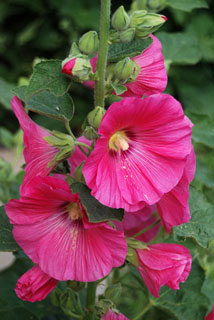HOLLYHOCK
|
 |
| File Size: 80 KB |
|
|
|
Alcea rosea L.
|
| Pottawatomie County, Kansas |
| Biennial or short-lived perennial |
| Height: 3-10 feet |
| Family: Malvaceae - Mallow Family |
| Flowering Period: May, June, July, August, September |
|
| Stems: | | Erect, straight,mostly unbranched, coarse-hairy. | | Leaves: | | Alternate, nearly round, 2 to 12 inches wide, wrinkled; margins shallowly 5-7-lobed or wavy, principal veins palmate; base heart-shaped; stalks long, to 12 inches on leaves of basal rosette, progressively reduced above. | | Inflorescences: | | Raceme, spike-like, terminal. | | Flowers: | | Showy, around 4 inches broad; stalk short; bracts below calyx 6-9, triangular, united basally; calyx 5-lobed, 3/5 to 4/5 inch long, lobes broadly triangular; petals 5, 1.2 to 2 inches long, overlapping, usually with shallow indentations at top, pink, rose, red, purple or white; stamen column with anthers at tip. | | Fruits: | | Rings of 15-40 1-seeded segments, outer surface pubescent. | | Habitat: | | Waste places, roadsides, railroads, fields, farmsteads. | | Distribution: | | Scattered throughout | | Origin: | | Probably a native of Asia. Introduced and now naturalized in the United States. | | Uses: | | Native Americans used the leaves to apply an infusion of flowers to skin inflammations. | | Comments: | | Hollyhock was cultivated in flower gardens and sometimes escaped to waste places. It can be found in a wide variety of colors but escaped plants are often pink or rose. |
|
| Hollyhock flowers, bracts, and calyx |  | | 88 KB | | Pottawatomie County, Kansas |
| | Hollyhock inflorescence |  | | 92 KB | | Pottawatomie County, Kansas |
| | Hollyhock leaf |  | | 72 KB | | Pottawatomie County, Kansas |
| | Hollyhock |  | | 72 KB | | Marshall County, Kansas |
| | Hollyhock |  | | 72 KB | | Marshall County, Kansas |
|
|
|
|
|
|
|